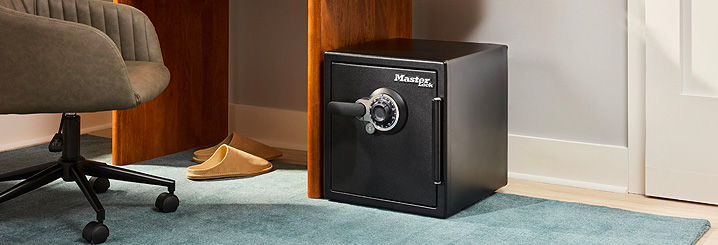- Home >
- Security and Safety Insights >
- How to Care for Your Safe and the Valuables Inside It
How to Care for Your Safe and the Valuables Inside It

Water and fireproof safes are expertly designed to safeguard your most important belongings from disasters. However, the airtight seal that protects your documents, photos and hard drives from fire and water damage can also trap moisture from the air inside your safe. This moisture buildup can pose a risk to your belongings, even causing mildew that could damage the very items you intended to protect.
Fortunately, there are several routine maintenance steps you can take to maximize the protection your valuables get from your fireproof safe.

Prevent Moisture Damage with Desiccants
Controlling moisture is one of the most critical aspects of fireproof and waterproof safe upkeep. Without proper ventilation or humidity control, safes can trap damp air inside — especially if you live in a humid climate or store your safe in the basement. Over time, mold and mildew can germinate, which can degrade documents, tarnish jewelry and potentially damage digital storage devices. Luckily, desiccants can help prevent moisture accumulation that could damage your safe and belongings.
What Are Desiccants?
Desiccants are moisture-absorbing packets that help regulate the environment within your safe, providing moisture and vapor protection by drawing humidity in to prevent condensation. We recommend replacing safe desiccants with new packets every 6 months or reactivating them by heating them in an oven at 245°F for 16 hours. For effortless upkeep, you can purchase a SentrySafe desiccant subscription to automatically receive new desiccant packets every six months — no reminder needed.
How to Air Out a Safe to Prevent Moisture Buildup
Even if you change your safe’s desiccant packets regularly, routinely opening and airing out your safe is another important way to prevent moisture damage. While your safe should remain closed and locked most of the time, opening it every 2 to 4 weeks helps release built-up moisture. Leave the door open for a few hours and make sure there’s good airflow to the safe.
During this time, be sure to inspect the contents and the interior for signs of humidity, such as:
- A musty smell
- Damp walls or interior
- Warped or curled papers
If your safe smells a little musty, remove your valuables and wipe down the interior walls with a mild solution of soap and water before drying the interior with a clean cloth. For added protection, we recommend storing moisture-sensitive or delicate items like jewelry, photos, stamps and important documents in airtight plastic containers or bags. This is a simple but effective way to help protect your valuables from trapped humidity and moisture damage.

Add an Extra Layer of Protection with a Fire-Resistant Document Bag
To further protect your important valuables both inside and outside your safe, we recommend storing documents like birth certificates, passports and USB drives in a SentrySafe fire-resistant document bag. These fire bags are designed to withstand high temperatures and feature a special coating to repel water, offering an additional layer of protection inside your safe. They also help you save valuable time in an emergency by keeping important documents in a convenient and portable grab-and-go bag.
Register Your Safe and Protect Your Combination
Storing the keys or combination for your safe in a secure location is just as important as protecting the valuables inside it. While it may seem obvious, you should always store your keys in a secure but memorable location and never leave the keys inside the safe. Registering your SentrySafe product or Master Lock safe ensures that if you do happen to lose or forget your combination, you’ll never have to pay a service charge to recover it. Just save your combination and product information to your account, and you’ll be able to login to access your combination whenever you need it.
If you’re ever locked out of your safe, always contact our customer support team first instead of calling a locksmith. Our team of experts can often help you access your safe over the phone and can provide the factory reset combination if you need it. However, it’s critical that you keep your factory-set combination private, as these codes aren’t easily changed and could make your valuables vulnerable to theft.
Your Safe Upkeep Guide:
- Replace or reactivate desiccant packets every 6 months
- Air out your safe every 2-4 weeks
- Seal your valuables in an air-tight plastic container or bag
- Use a fireproof document bag for added protection
- Register your safe online after purchase
- Store your keys or combination in a secure, memorable location
Your water and fireproof safe is built for long-term protection, but like any tool or appliance, it will perform best with regular care. With routine maintenance and humidity control, you can prevent mildew and ensure your belongings get lasting protection from your fireproof safe.




